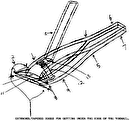
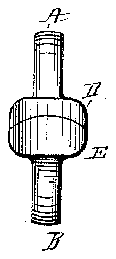
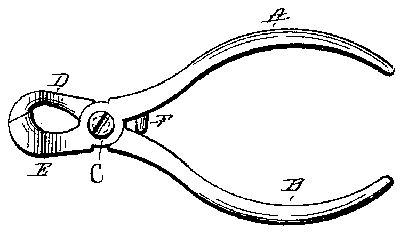
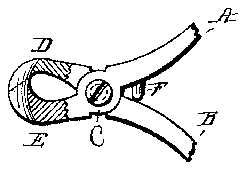
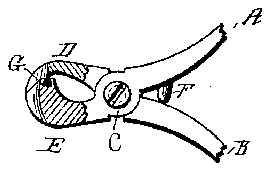
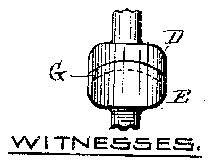
- 3fi
- 13lvitnesses: walter
Description
(No Model.)
B. H. PRICE. DEVICE FOR TRIMMING FINGER NAILS.
Patented Apr. 21, 1891.
lEnEl- INVENTEIRI M/K [71, Q
RAYMOND II. PRICE, OF PROVIDENCE, RIIODE ISLAND.
DEVICE FOR TRIIVIMING FINGER-NAILS.
SPECIFICATION forming part of Letters Patent No. 450,703, dated April 21, 1891.
Application filed January 28, 1891. Sen'al No. 378,798. (No model.)
T0 (6 whom it may concern:
Be it known that I, RAYMOND II. PRICE, of Providence, in the State of Rhode Island, have made certain new and useful Improvements in Devices for Trimming Finger-Nails; and I do hereby declare that the following specification, taken in connection with the drawings making a part of the same, is a full, clear, and exact description thereof.
Figure l is a side view'of my device. Fig. 2 is a front or end view of same. Fi 3 is a top view. Fig. at is a vertical section of jaws on line X X. Figs. 5 and 6 are sectional and front views, respectively, of the jaws, showing softmetal seat.
The object of my invention is to produce a device for trimming the finger-nails which shall be capable of removing the entire outer or superfluous edge of the nail at one operation, and at the same time more completely conform to the natural shape of the nails both in their horizontal and vertical curve; and it consists in the construction and operation of the several parts of the device, as hereinafter described.
In the drawings, A and B, Figs. 1, 2, 3, and I, are the two hand-levers pivoted together at C like a pair of pliers or cutting-nippers and terminating in jaws D E at the other end.
F is a pin or stop, which arrests the further pressure as soon as the jaws are closed.
The jaws D E are curved upon their outer ends to conform to the horizontal curve of the nails, which is more clearly shown in Fig. 3 of the drawings. The cutting-faces of the jaws are not straight, the upper one D being concave and the under one E being convex to conform to the vertical curve of the nails. It will now be observed that the device can readily be adjusted to the nail in both directions at the same time and the superfluous portion thereof removed at a single operation without wringing or twisting the nail, as would be the case were the cutting-edges straight. The lower jaw E may be provided with a seat G, Figs. 5 and 0, of Babbitt or other suitable metal, having a slight groove or crease to receive the edge of thenpper jaw D, which will add somewhat to its efiiciency, although such seat may be omitted and a good result obtained.
lVhat I claim as my invention, and desire to secure by Letters Patent, is-
The device herein described for trimming the finger-nails, consisting of pivoted handlevers A l), with their cutting-jaws D E, concaved at the ends and having their respective cutting-surfaces concave and convex, the whole constructed and operating in the manner substantially as specified.
RAYMOND ll. PRICE. lVitnesses:
WALTER 13. VINCENT, JOSEPH H. FLAHERTY.

